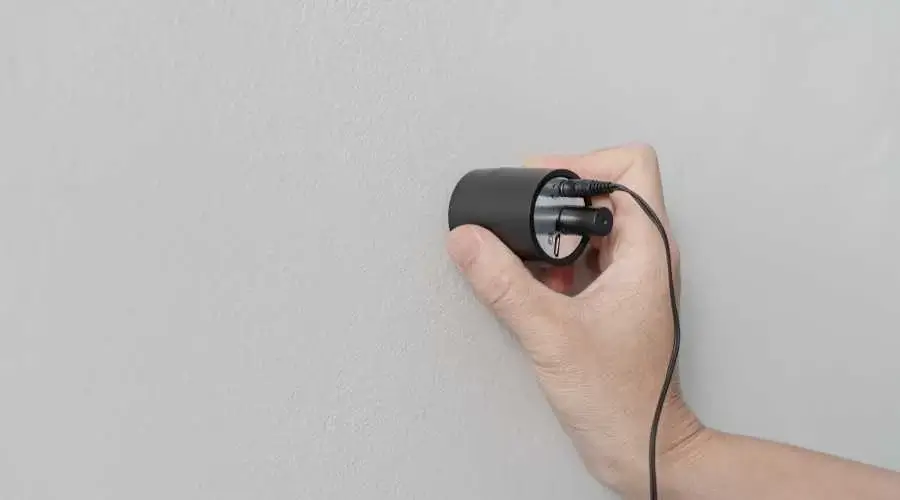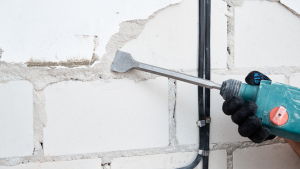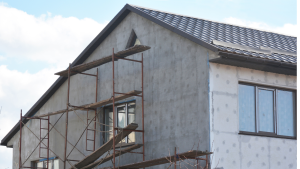A hazardous problem is stucco water infiltration. Although stucco siding is appealing for house siding because of its design, several problems may result in water infiltrating the siding if it needs to be done correctly.
Responding promptly to stucco water infiltration is critical since it may result in mold growth and other water damage problems. The first step in avoiding and managing stucco water intrusion in your house is understanding how it occurs.
How Can Water Infiltrate Stucco?
How can stucco water penetration occur when stucco is meant to give a robust, seamless siding choice that can withstand water without any problems? Water may infiltrate stucco siding through direct absorption, crack entry, faulty installation, or infiltration.
Direct Infiltration
When sealed, stucco is supposed to be watertight. However, this is only sometimes the case. Numerous factors may cause water to immediately penetrate the stucco surface, which can subsequently result in an expanding stucco water intrusion issue. Wicking may make the water penetrate quite deeply after it has penetrated the surface.
Water may seep through the stucco if it comes into constant touch with moisture. If the surface is not constantly moist, it should withstand the weather without any problems. Water, though, has a way of getting inside. You may have stucco water penetration if you have sprinklers that
unintentionally keep the walls moist or any other ongoing water source.
Entering Through Cracks
Naturally, complete and solid stucco only serves as a water barrier when it is done and reliable. Cracks might become visible for any reason and allow water to enter. They could grow and migrate when inside, leading to worse cracks that will enable more water to enter.
Numerous factors might cause cracks to appear. If your home changes over time, microscopic cracks could appear outside. This alone does not constitute a systemic issue. However, it may let water in, leading to mold development and other problems.
Improperly Installed Flashing
Although stucco may be a highly effective barrier, it cannot surround your home. Sometimes windows, the bottom of your roof, and other fixtures and structures may come into contact with your stucco exterior. At these sites, moisture is kept out using flashing and moisture barriers.
However, poor installation may prevent water from seeping into the stucco in these locations. Remember that even a little quantity of water that manages to seep inside might eventually cause severe damage.
What Factors Can Contribute to Water Intrusion?
A variety of distinct circumstances may cause water infiltration. The development of plants on the stucco surface, different installations outside your property, and other elements could all be involved.
It’s essential to be aware of these possible risks in advance. Over the years, they could create undetected harm, resulting in mold growth and decay throughout your house. To prevent your stucco siding from water intrusion, be sure to go over these crucial details.
Planters and Plants Too Close to Walls
Plants too close to exterior walls quickly lead to significant issues. The fact is that soil contains a considerable quantity of moisture. If dirt touches your stucco siding, it will gradually absorb moisture.
If you have planters, flowerbeds, or garden boxes against the side of your home, they may be seriously damaging the structure. Any plant that spreads its roots too far from your siding might create an excessively moist environment that is detrimental to the long-term maintenance of your siding.
Light Fixtures
Exterior lighting fixtures are one of the most common ways water enters the stucco. The moisture barrier is often incorrectly fitted in the hole created by these for the light fixture box carved out of the stucco. Rainwater may very easily leak within the walls as a result.
Light fixtures are the most prevalent issue, yet they are far from the only one. Any installation outside might result in the same problem. Of course, any external taps might lead to water intrusion. A deck or patio connected to the home might allow water to enter if it is not adequately segregated.
You can also have this problem if various kinds of siding are used on different parts of your property. Since different siding types have their considerations, it may be challenging to guarantee that every such seam is treated effectively. If you ensure that a professional installs your siding, you can prevent this issue.
Ivy and Other Growth
Do you have ivy growing on your stucco siding? Your home may be harmed even if you find it lovely. A plant called ivy utilizes rootlets to cling to walls. These protrusions may breach the stucco’s outer layer, allowing moisture to enter.
Ivy may ultimately cause significant damage and allow considerable moisture to enter. Ivy should be included as most homeowners wouldn’t think a lovely plant could be harmful, but you shouldn’t disregard other possibly harmful plants.
Moss might do just as much, if not more, damage to your stucco siding. Its roots can intrude deeply through the surface, letting moisture soak in and permeate the walls. Even though homeowners are less likely to let moss grow uncontrolled on the side of their property, you must act quickly to avoid damage.
Deal with Stucco Water Intrusion the Right Way
Do you believe your home may be affected by water penetration via stucco? If so, contact CMB Jersey City Stucco & EIFS Repair to learn more about your alternatives. Along with giving treatments to help avoid future problems and selecting siding options, we can fix damaged stucco and remove it if necessary.




